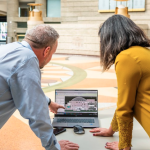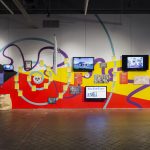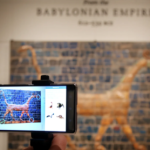As technology and digital experiences infiltrate all aspects of our lives, Detroitisit thought it would be interesting to find out how it’s use is impacting Detroit museums and cultural institutions.
We found out that our local institutions are not only embracing technology but pioneering innovation and acting as models for other institutions around the country. Be it for visitor experience, operations, facilities management, or sustainability, these institutions are implementing innovation to significantly improve upon what they bring to the community.
A great example of this is the Wright Museum. Wright has become a “Smart Museum,” an umbrella term it uses for its three primary areas of focus: Smart Facilities Management, Smart Exhibitions, and Smart Sustainability. The overall goal of becoming a smart museum is to greatly enhance the museum’s ability to access, collect, and analyze operational data with outcomes to include a significant increase in efficiencies, sustainability and ClimateUX (climate experiences).
To achieve this goal, they worked with Autodesk to create a digital twin – a replica of their building that lives on the cloud and provides insight to their operations for each sector of the museum.

THE WRIGHT DIGITAL TWIN
“We have laid a great foundation,” said Leslie Tom, Chief Sustainability Officer at the Charles H. Wright Museum of African American History.
Having this information allows us to do our work so much more effectively and collaboratively. We don’t have to spend time identifying outlets and lighting and understanding basic building usage and physically assessing the building. We can collaborate with architects, designers, and engineers more efficiently. And we have smart facilities management that helps us on the sustainability side.
Said Jeffrey Anderson, the Wright’s Chief Operating Officer, “It is our president, Neil Barclay’s vision to continue to establish the Wright as a leader of African American culture and history in the U.S. and advancements in technology will help us do this.”
In 2022, following a nationwide search, the Detroit Institute of Arts (DIA) hired Dr. Jennifer Snyder as the museum’s first Chief Digital Officer (CDO) to set the strategic direction for digital design, user experiences, digital production and publishing,
information technology, and digital processes.
“I look at technology as a facilitator to make the museum’s content more accessible,” said Snyder, who’s been working to update the museum’s infrastructure to facilitate this. By the end of this year, she expects this infrastructure to be in place.
The Michigan Science Center uses technology to help engage visitors in an immersive way. Andy Zulkiewski, Director of Guest Experience points to their four high-tech theaters as an example, and also their new “Above and Beyond” interactive exhibition exploring transformative innovations in aerospace.
“The 6,000 square foot exhibition offers flight simulation, immersive theater, touch-table displays, and augmented reality, offering an experiential understanding of the scientific concepts behind flight. It’s fully immersive and guests love it,” said Zulkiewski.
About the role tech plays at the MOCAD, Marie Madison-Patton, Chief Operating Officer says, “From Roxy Paine’s Auto Sculpture Maker as part of our inaugural “Meditations in an Emergency” exhibition in 2006 to our most recent presentation of KESSWA’s “Transcendence” using virtual reality to consider liberatory movement of Black femmes, MOCAD has continually aimed to present contemporary art that engages with and questions technology’s role in society.”

MOCAD
In 2019 MOCAD launched an online exhibition platform called Daily Rush. New seasons of Daily Rush are released semiannually, with works by visual artists and filmmakers whose production lies in-between digital media, contemporary art, and moving images. Presented exclusively online, each season was organized around emerging ideas on digital culture and technology by artists and thought leaders from Detroit and beyond.
From a visitor experience perspective, Anderson points to the Wright’s Judge Damon J. Keith exhibition that is new this year. “Through an interactive experience, visitors experience the journey of Judge Keith’s life and it’s fully immersive.”
Snyder weighs in on the DIA saying,
We are looking at ways to make things not just interactive, but immersive. I’m using other great institutions as examples, like those in Europe and also the Cleveland Museum. The Metropolitan Museum of Art has a new active learning and play center for kids that’s amazing.
Jova Lynne, MOCAD’s Artistic Director says Detroiters are on the move and require multiple touchpoints. “We aim to make all of our content mobile-friendly, whether that be on our website, email marketing, or social channels,” she said.
When it comes to challenges that accompany technology, each institution has them.
Snyder says,
Museums think in hundreds of years, not fast evolution. They are like giant ships and trying to shift direction can be a slow process. Speaking to an audience that’s ever-changing and that’s familiar with technology that progresses in leaps and bounds can be a challenge. But we are also in a great position to adopt new technology and experiment because of the long-term stability that museums enjoy.

DIA IMMERSION
“Staff familiarity can be a challenge with technology, said Zulkiewski. If the system goes down, the whole staff has to be trained in how to address it or we are in trouble.”
Tom says data overload can be an issue. “There can be so much data that it’s hard to know what to focus on at times, and that can slow momentum,” she says.
Lynn speaks of inclusivity as a barrier that is also an opportunity. “At MOCAD we welcome creative voices who can guide us to an equitable and inclusive future,” she says. For some, new technology can not only be daunting but unwelcoming. How do we integrate the new while understanding the limitations of technology outside of an institutional setting?”
When asked about the future of technology, all eyes are on it.
“We want to be at the forefront of technology and lead innovations in the next visitor experience,” said Snyder of the DIA.
“We will always be focused on our guests having the ability to learn and interact,” said Zulkiewski. “Our exhibits have to be variable and never static. We are thinking about things like augmented reality, AI, more advanced applications, and drones as some of the ways visitors might interact at the Science Center in the future.”
As long as we are paying attention to the latest trends, the future is bright, said Tom. “We are always talking about the latest technology and how it’s being used, such as how AI might play a role. As long as we are staying on top of the latest advances we are in a good position.
Lynn closes by saying of MOCAD, “Flashy tech is always exciting, but it’s the technology that helps to improve our accessibility that we’re most excited about. Integrating QR codes in our exhibitions that allow for those with vision or hearing impairments to better engage with the artwork is a top priority. Ensuring our user interface is personalizable in our digital spaces will always be a top priority.”
As always, be sure to subscribe to our newsletter for regular updates on all things Detroit and more.






















